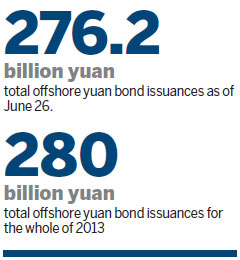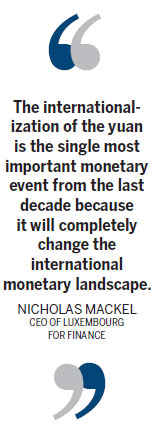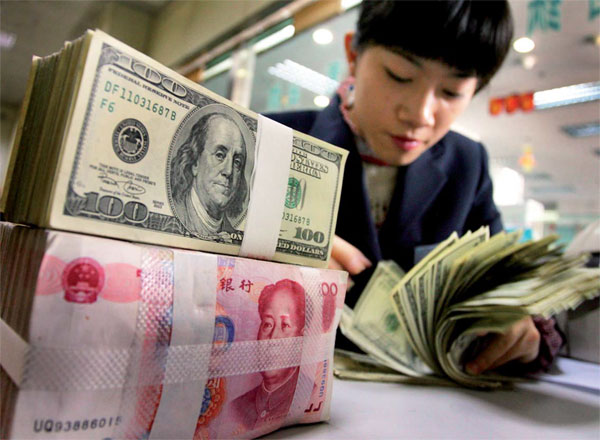Use of yuan for trade gets fillip
Updated: 2014-08-22 07:21
By Jiang Xueqing(China Daily Europe)
|
|||||||||||
|
China is promoting the wider use of yuan around the world to further internationalize its currency. Provided to China Daily |
Clearing, settlement arrangements extend to banks across Europe and Asia
China is strengthening its policy on yuan internationalization by promoting wider use of the currency around the world.
The People's Bank of China signed a memorandum of understanding regarding yuan clearing and settlement arrangements with the Bank of Korea on July 3, just several days after it signed similar arrangements with the central banks of Luxembourg and France.
Earlier in June, London and Frankfurt joined Hong Kong, Macao, Taiwan, Singapore and Malaysia in having designated yuan clearing banks. The PBOC appointed China Construction Bank in London and Bank of China in Frankfurt.
Deutsche Bank strategist Liu Linan said in a recent report: "We believe establishing yuan clearing banks in Europe is another major policy mile-stone in yuan internationalization, and with closer economic and business cooperation between Europe and China in the years to come, offshore yuan business has significant growth potential in Europe."
Liu says Europe is likely to become the second-largest offshore yuan market following Hong Kong. He expects a broader adoption of the yuan in EU-China bilateral trade and yuan settlement to triple to 5 percent to 6 percent of China's global trade in the next three years.

The European Union was China's largest trading partner in 2013, with bilateral trade accounting for 13 percent of China's $4.16 trillion (3.11 trillion euros) global trade volume. Although the yuan trade settlement volume has grown rapidly in recent years, the amount of yuan cross-border trade settlement in Europe accounted for less than 1.7 percent of China's global trade as of 2013, according to the report.
The nation has taken increasingly rapid steps toward internationalizing its currency since it established an offshore yuan market in 2004 with the launch of personal yuan banking in Hong Kong. In 2010, Hong Kong was declared the first offshore yuan center.
During the past three or four years, the yuan has become one of the top currencies in trade settlement. It is now the world's seventh most-used currency in goods and services payments, having climbed from 20th rank in 2013, according to data from international financial communications platform SWIFT.
It will become an interesting currency in investment and as a reserve currency, says Nicholas Mackel, CEO of Luxembourg for Finance, a promotion agency for the Luxembourg financial sector.
"The internationalization of the yuan is the single most important monetary event from the last decade because it will completely change the international monetary landscape," Mackel says.
Leading European financial centers are all wooing China to become the regional center for offshore yuan businesses, after China designated the first yuan clearing bank outside the country in Singapore in 2013.
Mackel says interest in yuan internationalization is high. Major European financial centers, active in different fields, are competing for the attention of the Chinese.
London is strong when it comes to foreign exchange and derivatives. Frankfurt and Paris are strong in terms of trade settlement. Luxembourg's strengths are investment funds, bonds, deposits and loans.
"For the Chinese, we are complementary because each of us offers China our traditional strength and can offer a different channel to internationalize its currency," Mackel says.
Clifford Lee, head of fixed income at Singapore-based DBS Group Holdings Ltd, says: "So far the regulators in China seem to like the multi-clearing center situation. Because they like what they see, they're going to continue to roll out (more offshore yuan clearing banks). In the immediate future, you'll see that trend.
"Once a certain amount of flow is established outside China, it's very possible that they will start to consolidate," Lee says.

The regulators have wisely taken measured steps, looking at the reaction and the development before going the next step, Lee says.
He says it is the fundamental use of the yuan that is going to drive the offshore yuan market.
"The more you make the yuan relevant in terms of application, the faster the market will develop," he says.
Yuan internationalization has continued to grow in recent years on the back of strong policy support by the government and the creation of additional offshore yuan clearing arrangements and currency swap lines with overseas central banks.
The lack of offshore investment options has continued to drive the huge demand for yuan bonds.
As of June 26, total offshore yuan bond issuances had reached 276.2 billion yuan ($44.5 billion; 33.3 billion euros), compared with 280 billion yuan for the whole year 2013.
Lee estimates that offshore yuan issuance is likely to remain buoyant in the second half of 2014 and beyond.
In addition to increased issuance volume, more international issuers have tapped into the offshore yuan market, although Hong Kong issuers continue to form the bulk of the market.
Non-Asian corporates had issued 16 billion yuan worth of offshore yuan bonds by June 26, compared with 27.9 billion yuan last year, Lee says.
The People's Bank of China is preparing to launch the China International Payments System to replace a patchwork of networks and allow hassle-free yuan payments.
By developing and researching CIPS, China is building an expressway for the yuan to become fully convertible on the capital account.
The system is an infrastructure for the cross-border use of the yuan and will have a deep impact on the internationalization of the currency, says Li Bo, head of the Monetary Policy Department II of the PBOC.
jiangxueqing@chinadaily.com.cn
(China Daily European Weekly 08/22/2014 page23)
Today's Top News
Telegram good gesture from Pope to China
Japanese firms face $200m fine
Ice Bucket Challenge hits China
Gaza ceasefire talks collapsed
Heinz recalls four batches of infant food in China
WHO says Ebola has killed more than 1,200
Japan looking to buy more stealth fighters
2 Air Force jets collide in Italy, 4 airmen missing
Hot Topics
Lunar probe , China growth forecasts, Emission rules get tougher, China seen through 'colored lens', International board,
Editor's Picks

|

|

|

|

|

|






